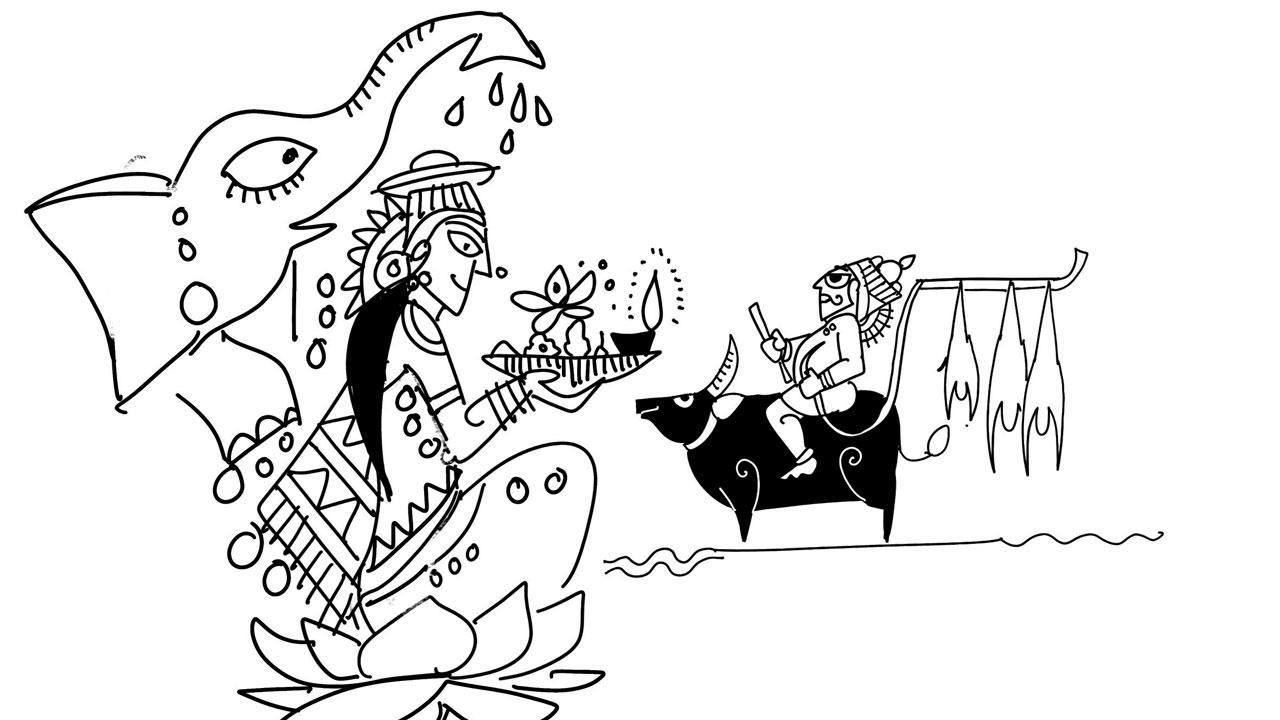Thus, we find the north and south traditions are very different, one favouring Ram, the other favouring Krishna.

Illustration/Devdutt Pattanaik
 Diwali in north India celebrates the return of Ram from Ayodhya. Diwali, or rather Deepavali, in south India celebrates the defeat of Narakasura by Krishna. In South Indian traditions, Diwali celebrations take place on the 14th day, that is, on the eve of the new moon day. It involves wives bathing husbands with oil and unguents, early in the morning, mimicking Satyabhama and Krishna. Then, there is the crushing of a cucumber-like fruit (karit) to represent the destruction of Narakasura. In Goa, effigies of Narakasura are burnt, and crackers at dawn. Thus, we find the north and south traditions are very different, one favouring Ram, the other favouring Krishna.
Diwali in north India celebrates the return of Ram from Ayodhya. Diwali, or rather Deepavali, in south India celebrates the defeat of Narakasura by Krishna. In South Indian traditions, Diwali celebrations take place on the 14th day, that is, on the eve of the new moon day. It involves wives bathing husbands with oil and unguents, early in the morning, mimicking Satyabhama and Krishna. Then, there is the crushing of a cucumber-like fruit (karit) to represent the destruction of Narakasura. In Goa, effigies of Narakasura are burnt, and crackers at dawn. Thus, we find the north and south traditions are very different, one favouring Ram, the other favouring Krishna.
ADVERTISEMENT
In the western part of India, amongst traders, the Diwali celebrations happen on the new moon day. They involve the opening of a new balance sheet: the day after Diwali is when Govardhan Puja is done and 56 types of food are offered to Krishna. Two days later, Yama is visited by his sister Yami, or Yamuna. Yamuna, the river, like all rivers, is linked to Lakshmi. Yama, god of death, trapped in the world of the dead, is linked via Chitragupta, to karmic accounting. Thus, the sister, who embodies wealth, seeks welfare of her brother who ensures humanity (her husband) treats her with respect, responsibility
and accountability.
Diwali new moon is also associated with the rise of Bali, king of Patala. The following day he goes back to the nether regions. This ascent and descent of Bali and asuras is linked to growth of crops and harvests. The arrival of the asura-king is marked by games of gambling played on Diwali new moon night.
In Vedic times, the negative forces were linked less with demons and more with ancestors (pitr) and ghosts (bhoot). And so, in eastern parts of India, Diwali is linked not with asuras but with the dead. The eve of Diwali is called Bhoot Chaturdashi, where 14 lamps are lit and 14 different forms of food are prepared for the ancestors in Bengal. Diwali is linked to Kali. The worship of Lakshmi happens a fortnight earlier on the full moon night of Sharad Poornima.
In the Jagannath Temple of Puri, Odisha, a huge gathering of people takes place. Here, people perform shraadh, and feed ancestors. They light lamps to show ancestors the path to return to the land of the dead (pitr-loka). The ancestors come to earth when Jagannath Rath-yatra ends. They leave when Chaturmaas (four months of monsoon) draws to a close and Vishnu is about to wake up.
Ancestor worship has been going on in India since Vedic times. The Vedic householder would make offerings, facing the east, to the gods during spring and summer seasons. However, the monsoon, and subsequent autumn and winter festivals, are linked to ancestors, ghosts and, in later times, came to be linked to asuras and demons. Thus Pitr-loka, or land of the dead, is linked with Patala, subterranean realm of asuras, and Naraka, the hell of those trapped with debts. Diwali recognises these beings and encourages generosity and charity as the only way to end debts and liberate the dead from the wheel of rebirths.
In a world, where north Indian mythology overshadows all other Hindu mythologies, from the eastern, western and southern part of India, it is good to remind ourselves of other traditions that speak of Hinduism’s diversity.
The author writes and lectures on the relevance of mythology in modern times. Reach him at devdutt.pattanaik@mid-day.com
 Subscribe today by clicking the link and stay updated with the latest news!" Click here!
Subscribe today by clicking the link and stay updated with the latest news!" Click here!







